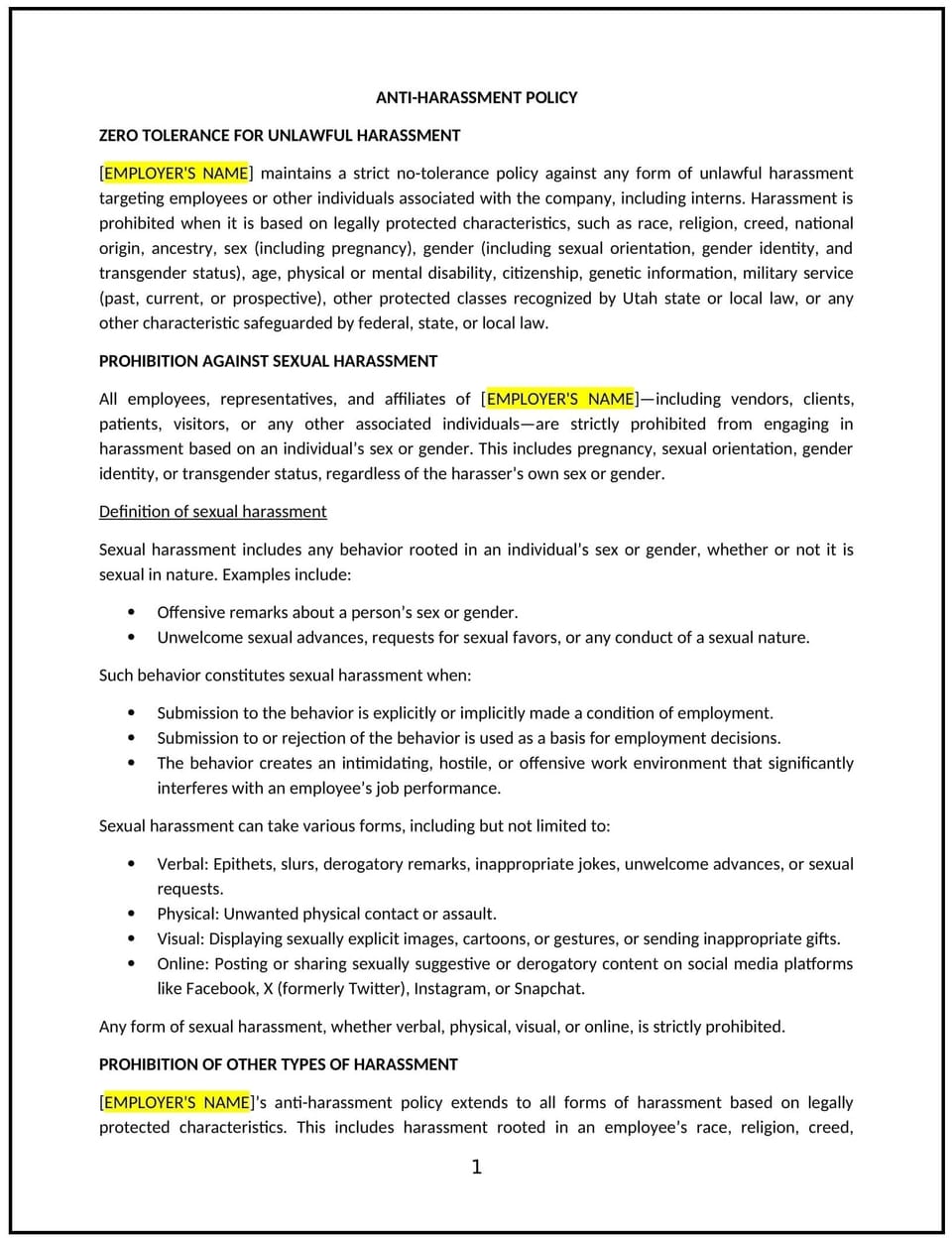Anti-harassment policy (Utah): Free template

Anti-harassment policy (Utah)
This anti-harassment policy is designed to help Utah businesses create a safe and respectful workplace by addressing and preventing harassment. It outlines prohibited behaviors, reporting procedures, and steps for addressing complaints to foster a positive work environment.
By adopting this policy, businesses can promote a culture of respect, reduce the risk of workplace conflicts, and align with general best practices for maintaining a harassment-free workplace.
How to use this anti-harassment policy (Utah)
- Define harassment: Clearly outline behaviors considered harassment, such as verbal, physical, or visual conduct based on protected characteristics.
- Establish reporting procedures: Provide employees with multiple channels to report harassment, including anonymous options.
- Train employees: Educate employees and managers on recognizing, preventing, and addressing harassment.
- Investigate complaints: Outline a fair and impartial process for investigating harassment claims.
- Enforce consequences: Specify disciplinary actions for policy violations to reinforce its importance.
- Protect against retaliation: Ensure employees who report harassment in good faith are protected from retaliation.
- Review and update: Regularly assess the policy to ensure it remains effective and relevant.
Benefits of using this anti-harassment policy (Utah)
This policy offers several advantages for Utah businesses:
- Promotes a respectful workplace: Encourages a culture of dignity and respect for all employees.
- Reduces legal risks: Helps businesses address harassment proactively, minimizing potential disputes.
- Enhances employee morale: Demonstrates a commitment to employee well-being and safety.
- Aligns with best practices: Provides a structured approach to preventing and addressing harassment.
- Builds trust: Encourages open communication and transparency in handling complaints.
Tips for using this anti-harassment policy (Utah)
- Communicate the policy: Share the policy during onboarding and include it in the employee handbook.
- Provide training: Educate employees and managers on recognizing and preventing harassment.
- Encourage reporting: Foster an environment where employees feel safe reporting harassment.
- Investigate promptly: Address complaints quickly and impartially to maintain trust.
- Monitor effectiveness: Regularly review the policy to ensure it meets workplace needs.
Q: How does this policy help businesses reduce legal risks?
A: By clearly defining harassment and establishing reporting procedures, businesses can address issues proactively, minimizing the risk of lawsuits or regulatory penalties.
Q: What steps can businesses take to ensure the policy is effective?
A: Businesses should provide regular training, encourage reporting, and investigate complaints promptly and impartially.
Q: How does this policy improve workplace culture?
A: By promoting respect and transparency, this policy helps create a positive work environment, which can boost employee morale and productivity.
Q: What should businesses do if a harassment complaint is reported?
A: Businesses should follow the investigation process outlined in the policy, ensuring fairness and confidentiality throughout.
Q: How often should businesses review this policy?
A: Businesses should review the policy annually or as needed to ensure it remains effective and aligned with workplace needs.
This article contains general legal information and does not contain legal advice. Cobrief is not a law firm or a substitute for an attorney or law firm. The law is complex and changes often. For legal advice, please ask a lawyer.


